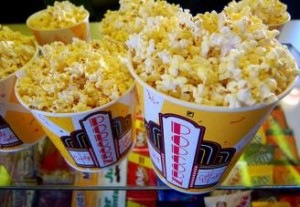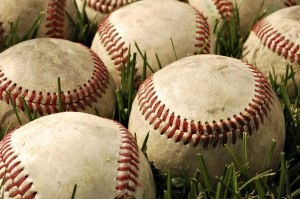I went to the movies Saturday night. It was a long, long day and I was tired – so my guard was down. As I walked into the theater the first thing that hit me was the wafting and delicious smell of freshly popped (and it was freshly popped in this theater) popcorn. I could have had a label plastered across my forehead: sucker coming around the corner, start filling the popcorn bag! Elbow in my husband’s ribs: buy some!
It was the first time I’ve had movie theater popcorn in about two years. Not that I don’t love it – I do. I also know a little bit about it. Thing is, after writing another post about popcorn I even asked the guy behind the concession stand several months ago what they pop their popcorn in. “Oh, I think it’s some combination of coconut oil and other stuff.” Fat gram numbers spiraled and multiplied in my head. Yet, the siren call of freshly popped popcorn was too strong to overcome.
I Don’t Care, I’m Going To Have It Anyway
I had set myself up for a “I don’t care, I’m going to have it anyway” caloric splurge. Why? I was hungry, tired, and it was the tail end of a very busy week. And, two other important factors: our friends had already bought their popcorn (ever sit next to someone who is eating something you really like and that smells delicious?) and I really love popcorn.
SocialDieter Tip:
I’m not suggesting that you – or I – should never have movie theater popcorn. What I am suggesting is that If you are going to have popcorn it should be figured into your overall caloric balance. Popcorn today – lots of fruit and veggies the next day – or maybe earlier in the day. The same thing is true if your weakness is that box of Raisinets – or Goobers – or Milk Duds.
Not the greatest foods in the world, but if you are going to have them as an occasional splurge build the splurge into your day – or weekly – food plan. If you’re going to eat the stuff, at least do it mindfully. Oh – you could also not eat anything during the movie, it is only about two hours – or, you could bring some healthy snacks like a lower calorie protein bar or trail mix with you (a crunchy apple doesn’t lend itself to quiet eating). And ditch the soda for plain old water.
FYI: Some Popular Movie Theater Snacks – And Their Calorie Counts
(Note the serving sizes, movie theater boxes of candy are often huge and may be double or triple the size shown below.)
Popcorn, Nachos, Soft Pretzel
- Buttered popcorn, small, 5 cups: 470 calories, 35g fat
- Buttered popcorn, large, 20 cups: 1640 calories, 126g fat
- Cheese nachos, large (4 oz): 1100 calories, 60g fat
- Soft pretzel, large (5 oz): 480 calories, 5g fat
Soda and Lemonade
- Coke, small (18 oz:218 calories, 0g fat
- Coke, large (44 oz): 534 calories, 0g fat
- Minute Maid Lemonade (18 oz): 248 calories, 0g fat
- Minute Maid Lemonade (44 oz): 605 calories, 0g fat
Candy
- Junior Mints, 3 0z box: 360 calories, 7g fat
- Sno Caps, 3.1 oz box: 300 calories, 15g fat
- Milk Duds, 3oz box: 370 calories, 12g fat
- Raisinets, 3.5 oz bag: 400 calories, 16g fat
- Goobers, 3.5 oz box: 500 calories, 35g fat
- Twizzlers, 6oz bag: 570 calories, 4g fat
- M&Ms, 5.3oz bag: 750 calories, 32g fat
- Peanut M&Ms, 5.3 oz bag: 790 calories, 40g fat
- Reese’s Pieces, 8oz bag: 1160 calories, 60g fat




